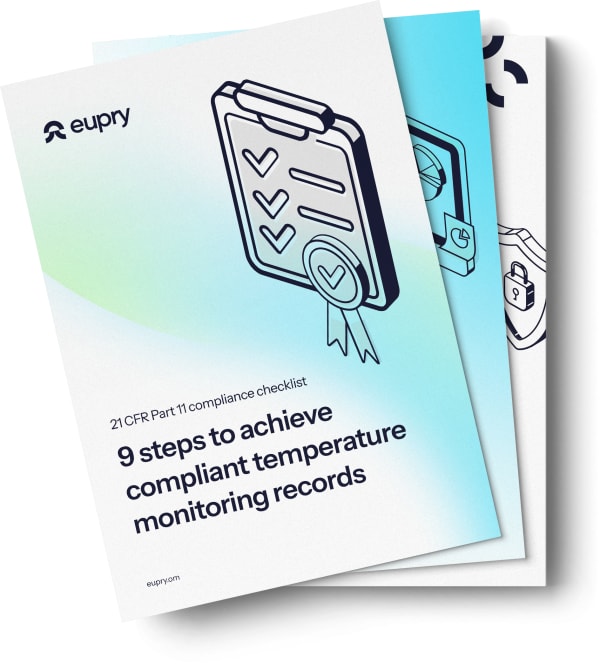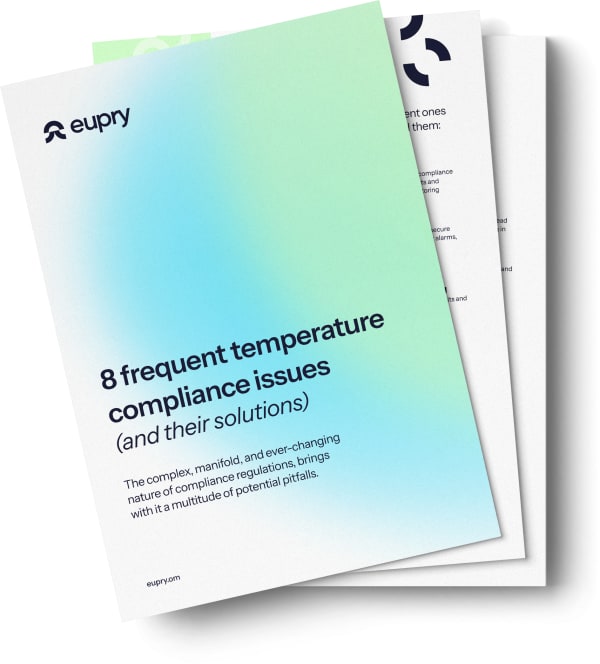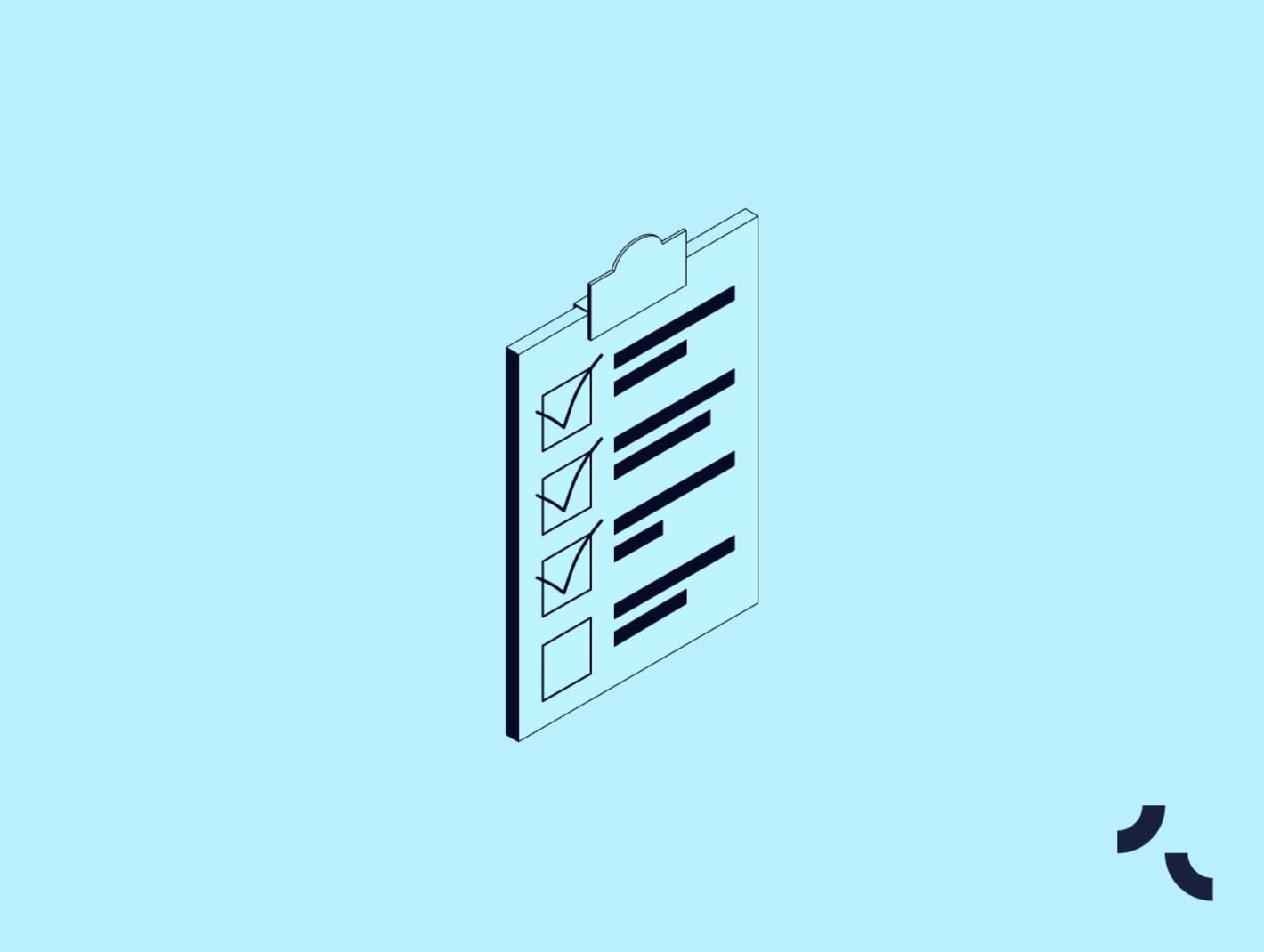Key regulations of temperature compliance

Jakob Konradsen
Are you spending too much time navigating regulations, yet remaining worried that you are not living up to all the requirements and following all the standards you should?
When working in highly regulated industries like pharma, biotech, and healthcare logistics, maneuvering the temperature compliance landscape can be a struggle.
Luckily, we have got you covered.
Let us run through the compliance areas you should be familiar with when working with temperature control – from monitoring to mapping and calibration – to help you navigate them confidently.

On this page, you can explore:
- What is temperature compliance?
- Why are regulations necessary for temperature compliance?
- Regulations, standards and guidelines – is there a difference?
- The key regulations and standards of temperature compliance
- 3 steps to implementing compliance in your operations
- How technology can make temperature compliance a non-issue
- 8 frequent temperature compliance issues (and their solutions)
- Frequently asked questions about temperature compliance
Not just temperature
Although temperature is our favorite child (and subsequently the focus of this page), many of the regulations and other compliance components are equally relevant to monitoring, mapping, and calibration related to humidity, CO2, differential pressure, and other environmental parameters.
What is temperature compliance?
In the world of pharma, drug distribution, and biotech, there are many different regulatory fields, and even if you work with quality, you might not have come across the phrase very often.
Nevertheless, the concept holds the potential to considerably optimize the way we work with temperature-related compliance issues within GxP.
The short version: Temperature compliance consolidates the quality tasks intended to ensure that temperature-sensitive products and samples are handled within specific temperature ranges during production, storage, and transport.
It compiles three main disciplines:
- Temperature monitoring
- Validation and temperature mapping
- Calibration of data loggers or sensors

Why temperature compliance should be handled as one
In most organizations, the domains of temperature compliance are handled more or less independently and by different departments operating independently with their own budgets on their own tasks, objectives, and priorities.
But this is both inefficient and risky.
These disconnected processes not only leave room for unnecessary, double efforts, bottlenecks, and idle time – they leave room for things falling between the chairs.
In other words, when monitoring, calibration, and mapping are not unified, you both risk having inefficient work processes and leave your compliance position vulnerable.
On the other hand, unifying lets you streamline processes, integrate data, improve efficiency, and mitigate risks.

Psst...
Eupry’s temperature compliance solution secures compliance and control of all your temperature-related quality efforts.
Why are regulations necessary for temperature compliance?
This is probably a no-brainer, but worth underlining nonetheless: Temperature compliance regulations are not there to make our work more time-consuming, complex, and frustrating (but let us be honest, it can often feel like it). Their sole purpose is to ensure that products remain effective and safe.
In healthcare logistics, pharma, biotech, and similar industries, a large range of products and samples are highly sensitive to even small temperature deviations. As a result, meticulous temperature monitoring and mapping are needed to secure quality. Regulations, standards, and guidelines are in place to ensure these processes are done correctly, ultimately safeguarding the integrity and safety of these vital products.

Regulations, standards, and guidelines – is there a difference?
In the quality context, standards, guidelines, and regulations each play their specific role in shaping practices and procedures – and compliance in highly regulated industries often involves adhering to a combination of all three elements to ensure safety and efficacy.
This section explores the different definitions and use cases for these principles:
Regulations in temperature compliance:
- Definition: Regulations are legal requirements created by governmental bodies or regulatory agencies. They are mandatory and enforceable by law.
- Characteristics: Regulations are often specific, providing detailed instructions or criteria that must be followed. They are legally binding, and non-compliance can result in legal penalties, including fines or sanctions.
- Examples: In the context of temperature mapping and monitoring, regulations might be issued by entities like the FDA (U.S. Food and Drug Administration), EMA (European Medicines Agency), or other relevant national health authorities.
Standards in temperature compliance:
- Definition: Standards are established by consensus among experts in a field and are often developed by standard-setting organizations, both international and national, such as the International Organization for Standardization ISO or the American National Standards Institute ANSI.
- Characteristics: Standards provide guidelines for practices, ensuring quality, safety, and efficiency. They are generally voluntary unless adopted by a regulatory body into a regulation. Compliance with standards is often necessary for market acceptance, certification, and sometimes regulatory compliance.
- Examples: ISO 9001 for quality management systems or ISO 17025 for the competence of testing and calibration laboratories are standards that, while voluntary, are widely recognized and adhered to in pharma, biotech, and healthcare logistics industries.
Guidelines in temperature compliance:
- Definition: Guidelines are sets of recommendations or best practices proposed by organizations, often based on research and expert consensus. They are not legally enforceable but are meant to guide industry professionals in specific areas of their work.
- Characteristics: Guidelines are usually more flexible than regulations or standards, offering recommendations rather than strict rules. They are designed to help organizations achieve better outcomes but do not carry the weight of the law.
- Examples: Good Manufacturing Practice (GMP) guidelines provide frameworks for manufacturers to ensure products are consistently produced and controlled according to quality standards, and Good Distribution Practice (GDP) guidelines ensure that the quality and integrity of products are maintained during storage and transportation. Note that, while these guidelines are not laws in themselves, they are often based on regulations.
To sum up: Regulations are legally binding and must be followed, standards are voluntary benchmarks that can become mandatory when adopted by a regulatory body, and guidelines are advisory, providing best practices to achieve the best results.

Understanding key regulations and standards of temperature compliance
Let us turn our attention to the specific regulations, standards, and guidelines relevant to your temperature monitoring, mapping, and calibration procedures.
Disclaimer: The following is a summary of standards commonly associated with temperature compliance initiatives. Please note that the specific standards applicable to your operations will vary based on your industry, the nature of your products, your clientele, and other relevant considerations.
FDA 21 CFR Part 11 – the digital compliance cornerstone
21 CFR Part 11 is a regulation that outlines the criteria under which electronic signatures and records – here among digital temperature records – can be considered trustworthy and reliable. It is part of the Code of Federal Regulations (CFR) established by the United States Food and Drug Administration (FDA).
Who is it relevant for?
The 21 CFR Part 11 regulation is relevant for companies involved in regulated industries such as pharmaceutical and biotechnology, that in any way operate in the US (partners, clients, distribution – it all counts), and utilize digital temperature monitoring systems – or simply keep some digital version of temperature records for compliance. So, pretty much everyone working with temperature-sensitive products. Learn more about FDA 21 CFR Part 11.


FDA 21 CFR Part 11 compliance checklist
Simplify 21 CFR Part 11 compliance for your temperature monitoring with our 9-step checklist.
FDA 21 CFR Part 211 – requirements for manufacturing pharmaceuticals
The FDA’s 21 CFR Part 211 (not to be mistaken with Part 11, although, we see how that might happen) is titled "Current Good Manufacturing Practice for Finished Pharmaceuticals."
This regulation covers the current Good Manufacturing Practice (cGMP) – the minimum requirements – for the methods, facilities, and controls used in the manufacture, processing, packing, or holding of a drug product to ensure that it meets quality standards and is safe for use.
Who is it relevant for?
This regulation is relevant for pharmaceutical manufacturers in the United States. It ensures that pharmaceutical products are produced under appropriate environmental conditions, including temperature control, to ensure their safety, purity, and efficacy

ISO 17025 – the benchmark for calibration and testing laboratories
ISO 17025 is the international standard for the competence of calibration laboratories. In other words, an ISO 17025 accreditation is a stamp of quality showing that a calibration lab lives up to the highest international standards for precision.
The standard is created by the International Organization for Standardization – ISO – an independent, non-governmental organization with 169 national standards bodies as members, each representing ISO in their respective country. The organization develops a wide range of proprietary, industrial, and commercial standards to ensure quality, safety, and efficiency across industries.
Who is it relevant for?
The standard is relevant for laboratories conducting calibration of temperature and humidity instruments to ensure accuracy and reliability in measurements.
For companies that do not have in-house calibration, an ISO 17025 accreditation might be relevant when looking for calibration suppliers or pre-calibrated data loggers for temperature monitoring or mapping.
The need for ISO 17025-accredited vs. for instance traceable calibration largely depends on the industry's regulatory conditions, the criticality of accurate measurements in operations, and the requirements of customers.
For non-critical measurements, low-risk industries, internal quality control, and alike, traceable calibration might be sufficient, but for strictly regulated industries with sensitive products, ISO 17025-accredited calibration is often required.

ISO 9001 – the stamp of quality management approval
ISO 9001 is a globally recognized standard for quality management systems (QMS).
It sets out the criteria for a QMS to ensure the consistent quality of products and services to meet both customer and regulatory requirements.
The standard is based on a range of different quality management principles, including customer focus, the involvement of company management, a process approach, and continual improvement.
For temperature compliance, the role of ISO 9001 is to ensure processes for temperature control are reliably managed and continuously improved, meeting industry standards. Whether it is ensuring the efficacy of pharmaceuticals or the reliability of medical devices, ISO 9001 lays the foundation for maintaining high-quality standards in temperature-sensitive operations.
Who is it relevant for?
The ISO 9001 standard is deliberately designed to be so general that almost all organizations can recognize themselves and utilize it to improve quality. It especially creates great value for organizations in industries where delivering consistent quality is vital. It applies to for instance pharmaceutical companies, biotech firms, medical device manufacturers, and any business involved in the lifecycle of health-related products.

GxP – the umbrella of good practices
GxP encompasses a range of compliance guidelines such as Good Manufacturing Practices (GMP), Good Laboratory Practices (GLP), Good Clinical Practices (GCP), and Good Distribution Practices (GDP).
These guidelines are essential in ensuring that products are safe, meet their intended use, and adhere to quality processes throughout their lifecycle. In the pharmaceutical context, GxP forms the foundation for regulating drug development and manufacturing.
Who is it relevant for?
Different variations of GxP guidelines are relevant for a broad range of organizations in sectors where quality and temperature compliance are critical – pharmaceutical companies, biotech organizations, clinical research, healthcare providers, laboratories, and logistics and distribution, especially when managing pharmaceutical products.
Also see: How to meet GMP temperature requirements (Annex 11 and Annex 15)

USP <1079> – guidelines for temperature-controlled storage and distribution
USP <1079> is a guideline developed by the United States Pharmacopeia (USP) – a scientific, non-profit organization that sets federally recognized, public standards for medicines, supplements, and food ingredients.
It outlines best practices for the storage and distribution of pharmaceutical products under controlled temperature conditions, maintaining product integrity throughout the supply chain and focusing on temperature monitoring, control, and documentation.
Who is it relevant for?
USP <1079> is applicable for organizations involved in the pharmaceutical supply chain, including manufacturers, distributors, and storage facilities. It is particularly relevant for entities handling temperature-sensitive pharmaceuticals, where maintaining specific environmental conditions is essential for product efficacy and safety.
While USP <1079> is specifically tailored for the pharmaceutical industry, the principles outlined in the guideline can be informative for other industries that handle sensitive products.

WHO – a world of mapping guidelines
The World Health Organization (WHO), an international guardian of public health, provides guidelines for safeguarding health supplies worldwide. These guidelines are designed to manage the complex process of storing and transporting health products across diverse climates.
Selecting the relevant WHO guidelines for you depends on your specific organizational needs and the nature of the products you handle – but Supplement 7: “Qualification of temperature-controlled storage areas”, Supplement 8: “Temperature mapping of storage areas”, and Annex 8: “Guidelines on heating, ventilation and air-conditioning systems for non-sterile pharmaceutical products offer targeted advice for different scenarios in temperature mapping.
Who is it relevant for?
The WHO guidelines in Supplement 7, Supplement 8, and Annex 8 are relevant for any sector managing the storage, handling, and distribution of temperature-sensitive products, ensuring product integrity and safety – from pharmaceutical companies to healthcare logistics organizations.
The guidelines are just that, guidelines, and not formal standards or regulations. But, although not legally required, they represent best practices and can be used as a guiding principle to secure the reliability of your temperature mapping studies. Also, as the WHO is a respected authority on health globally and its guidelines are considered well-founded, the guidelines are often used as a basis for national regulations.

Other relevant standards and guidelines

That was a lot…
3 steps to implementing compliance in your operations
We have gone through a myriad of regulations and compliance requirements for temperature control of pharmaceutical and other temperature-sensitive products and samples. Now, how do you keep auditors happy and incorporate the relevant rules and best practices into your operations? No size fits everyone, but there are three main fields to consider:
Using a (compliant) temperature monitoring system
What to look forImplementing a reliable temperature monitoring system and utilizing it compliantly is essential for temperature compliance. The systems should provide real-time monitoring, data logging, and instant alerting to maintain the integrity of sensitive products.
Performing regular temperature mappings
How to perform a compliant mappingTemperature mapping is used to validate that storage environments consistently meet the required temperature specifications – and performing them is part of regulations for most industries working with temperature-sensitive products. It involves a detailed analysis of temperature distribution within a storage area, ensuring uniformity and identifying any potential problem areas.
Using calibrated equipment
The foundation of reliable measurement. Regular calibration of temperature monitoring equipment is necessary for compliance in most industries. It ensures the accuracy of data loggers and sensors and the reliability of data.
Naturally,
this overview does not include every aspect of ensuring temperature compliance for your organization. However, these three areas – monitoring, mapping, and calibration – form the pillars of temperature compliance, and implementing reliable systems and processes for all three can work as a framework for developing a compliant setup.
Next up, how technology can help make this much simpler.

Automated temperature compliance in one place
Temperature compliance should not be hard.
Be in full control of your temperature compliance at all times. Collect monitoring, mapping, and calibration in one GxP-compliant solution.
How technology can make temperature compliance a non-issue
Navigating temperature compliance means navigating a comprehensive range of regulations, standards, and guidelines, which can be confusing and overwhelming.
Luckily, over the last years, technical advancements and digital monitoring solutions have emerged, designed to make compliance a non-issue for the users.
Live and automated temperature tracking
to enable immediate action on deviations.
Advanced alarms
providing customizable alerts, filtering out grey zones, and tailoring notifications based on specific compliance needs.
Automated deviation logging
making registration, analysis, and reporting of excursions more efficient.
Audit-ready reports
generated with only a few clicks to simplify audits.
A single database
with <u>all</u> temperature data accessible in one place, including alarms, calibration certificates, and mapping protocols.
Calibration management
not only tracking calibration certificates but also schedules.
Compliance-specific features
like modules designed for FDA 21 CFR Part 11.
Varying levels of flexibility
in temperature thresholds to match your regulatory requirements.
And more
Some solutions also include access to specialist support who can provide guidance and support on your compliance issues.
In other words, modern solutions can be used to automate and streamline – and automating means removing manual mistakes and misalignments in record-keeping, making compliance more reliable.

Checklist: 8 frequent temperature compliance issues
(and their solutions) Temperature compliance is complex, and, as a result, mistakes happen. Dive into the most common issues of temperature compliance - and how you can avoid them.
Frequently asked questions about temperature compliance
We have already covered some of the most common questions about regulations and compliance for temperature monitoring, thermal mapping, and calibration.
- What is temperature compliance?
- Why are regulations necessary for temperature compliance?
- Regulations, standards and guidelines – is there a difference?
- Understanding key regulations and standards of temperature compliance
- 3 steps to implementing compliance in your operations
- How technology can make temperature compliance a non-issue
- 8 frequent temperature compliance issues (and their solutions)
- Frequently asked questions about temperature compliance

Besides these
here are some other questions we often get about regulations and guidelines for temperature compliance:
What we have learned
From FDA guidelines to ISO standards, managing the requirements of temperature compliance is essential – not only for the sake of compliance, but to secure the integrity of the vital, temperature-sensitive products and samples in industries like healthcare logistics, pharma, and biotech.
For this, a proactive approach is key. When the auditors knock on your door, it will most likely be too late.
Luckily, technological advances have made the process much simpler.
Modern monitoring systems and solutions automate and streamline temperature control and quality efforts to make the process of keeping up with regulatory requirements not only more reliable but also more efficient. Some solutions also unify previously siloed processes (yes, we do that), removing the risk of important tasks falling between chairs and subsequent issues.

3 places to dive deeper
1. Talk to an expert (for free)
Feeling swamped by regulations? Don't worry, our team is here to help. Book a free 15-minute consultation with one of our compliance specialists.
2. Read more
Explore temperature compliance by checking out our articles. Download our 9-step FDA compliance checklist and our 6-step guide to reduce manual tasks. Also, discover how to master temperature monitoring.
3. Watch more
Check out our on-demand video sessions that cover everything from grasping the essentials of 21 CFR Part 11 for temperature monitoring to insightful strategies for fully automating your temperature compliance processes.
